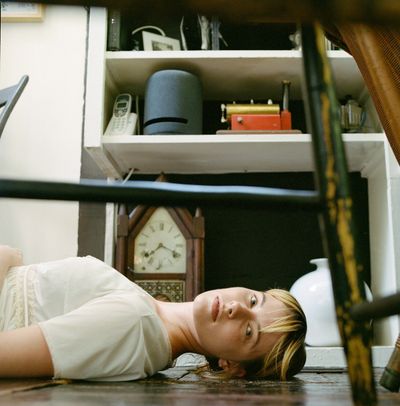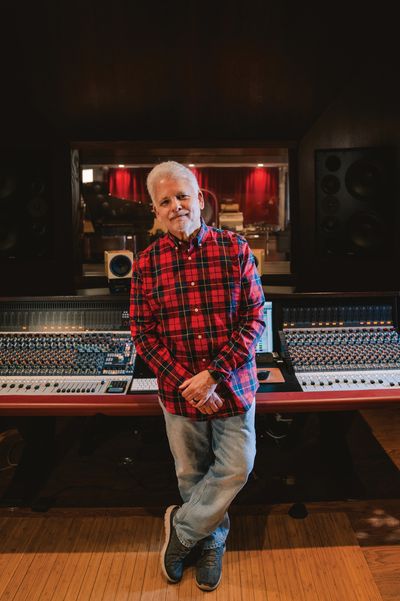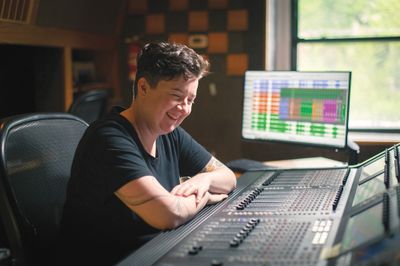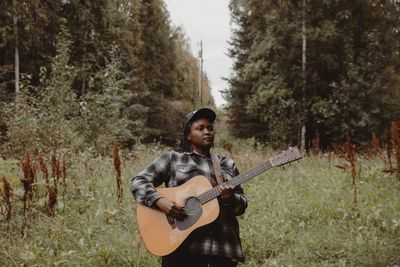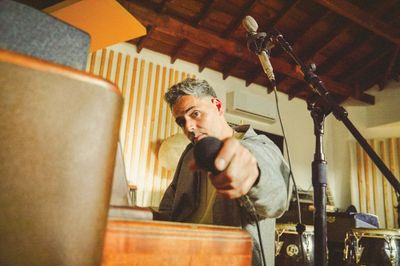Could you describe the difference between designing for mastering rooms versus mixing environments and recording studios?
My first mastering studio was Absolute Audio, which was the place that Murat Aktar, who is the president of Sterling now and had started back in the early '80s with a couple of other partners, Tom and Jim Brick. That was the first mastering studio I did. There are obvious differences between mastering studios and recording studios. There is no microphone work in a mastering studio. There is no place for musicians needed in a mastering studio. Typically, mastering studios are based on more of a hi-fi mentality and less of a "pro-audio" mentality. And the two are very, very different. Things that pass as top end in pro audio, up until very recently, most people in hi-fi or audiophile land would laugh at. And vice-versa. You don't walk into recording studios very often and find $5,000 speaker wires. That's fairly common in a mastering studio. You don't walk into a mastering studio and find, you know, a $300,000 console. The monitoring system is probably the single biggest difference.
Don't you build your own speakers now?
We do now. Having the opportunity to listen to audiophile monitors in an audiophile environment of our own design, and experience the kind of depth of imaging, and the 3-D experience of audio that you can very rarely get in recording studios — I strive to design recording studios that sound like that. I don't think there is anything wrong with things sounding really good in the recording studio. There's an old '60s, '70s and early '80s mentality that studio monitors should sound crappy, because if you make it sound great on crappy sounding monitors, then you really got something going. I subscribed to this theory for a long time. I still believe there are playback monitors and there are studio monitors. Studio monitors are generally hyped in the low-end and have a little bit of roll off on the top end so that you can listen loud and it doesn't hurt. Playback monitors, audiophile monitors, deliver a flatter frequency response when in the appropriate environment, and give you a more three dimensional audio experience, by the way they're designed. So, with the Griffin Speaker, we've tried to design a mastering quality loudspeaker that works in both mastering rooms and recording studios. We've been lucky enough to place the first pair that we ever built in Tony Dawsey's room in Masterdisk. And he's really thrilled.
You don't build them to spec, correct?
No. There's a freestanding model for mastering, and an in-wall model for recording studios. Interestingly enough, the only ones sold at this point are the freestanding model, but we originally designed it as an in-wall recording studio monitor. These recording studio projects that we had completed — and had put in very expensive pro audio monitor systems that will remain nameless — were, in our opinion, disappointing. The client was happy. We tuned the speakers, in other words equalized them and made them sound nice. But we were wondering where the $40,000 went. You know, a $40,000 monitor system, that's a lot of monitor. Using components that cost $20, using inexpensive cabinets, using off the shelf crossovers, nothing built custom for the system, off the shelf amplifiers. I challenged the guy who was my associate at the time, who had a hi-fi speaker building background, and I said, "You know, I really think these XYZ monitors we put in at so and so's place were very disappointing. Do you think you could do better?" He says, "I know I could do way better." So I bankrolled it, he designed it, and we built it.
Can you talk about bass traps a little bit, and how they're deployed both in the project and professional studios?
I think that bass traps are the things that are sorely missing from most homemade or tight budget studios that I see. And bass traps can take many, many forms. What I talk about when I say bass traps are broadband bass traps. Not tuned Helmholtz resonators, not tuned membrane traps, both of which we use. I mean broadband, porous absorption bass trapping. Lots of insulation stuffed in the corners. You can also trap a cavity behind some insulation or behind a membrane. There's a lot of ways to absorb bass frequencies. The classic mistake that a lot of people make is that they put up some or too much high frequency absorption. Foam or 1" or 2" thick fiberglass panels. And these panels or this foam does not absorb anything below 1000 to 2000 hertz. So all this low midrange and bass does not get controlled, and everything above it does, and you end up rooms that start to sound boomy. Even if the rooms have good proportions, the bass is decaying longer and sounds muddy and heavy, because all the high frequencies are being dampened. How can a guy do it on the cheap? Go to any corner you can get in the room. Any intersection of two walls, wall and ceiling. This is where the bass tends to accumulate. Go to any of these corners and cut out as much space as you can and fill it full of insulation. This is just a big porous bass trap, and all it's doing is taking this high energy wave at the boundary of the room and in the corner, having two boundaries coming together makes a double whammy, and it's turning it into heat by making the insulation move around a little bit with all the energy. And you will see room responses that look horrible really come down, and all these little spikes in the low end get rounded off and it gets a lot easier to listen to in a room that's properly bass trapped. I don't think you can have too much. A lot of my customers want to think that, "Well, there's not enough bass in my room, maybe there's too much bass trapping." That's not how it works. You need more bass traps. Because where you're sitting, there's probably no bass. But over there, there's probably a lot. So if I put a trap over there, what's going to happen is the sound that's congregating over there is going to come into the middle of the room, and I'll hear the bass come out into the room as opposed to being stuck around corners.
Pierre Marchand, Sarah McLaughlan's producer, records using headphones in a control room that does double duty as the artist performance area. What's your take on this approach?
Certainly, headphones eliminate the room. You know, if you find a pair of headphones you really like and you don't get what you hear in the room, put on the headphones! I've done a couple rooms like this for people, for private use. They either didn't have the room to have a dedicated recording room and control room, or they preferred this arrangement where there was enough room to have a band in to play, and set all the recording stuff up. So we built one big isolated box instead of two separated isolated boxes. Saved on the windows and doors between the rooms. I've found them, with the couple projects I've done, to be successful. I think that you have to understand that if you are going to take off the headphones and monitor in that room for mixing, that it has be addressed primarily as a monitoring environment and not primarily as a performance space. My experience is that the acoustics we use in control rooms, that amount of decay, and that amount of control, works really well in recording rooms. It's very natural sounding. When you walk into a good sounding control room and you speak, it's very comfortable. Well, rooms that are comfortable to speak in are generally comfortable to record in. You're not going to get the Carnegie Hall sound, you're not going to get the Power Station drum sound. If you want that, you need a dedicated room with long decay, you know? I find that a well-designed control room type acoustic is a very good place to record.
Could you tell me a little about how much the market has changed for you, say, over the last ten, fifteen years?
Good question. I would say that historically, my market has been very broad. That's the nature of having a small business. I can't say that we're just going to build multi-million dollar recording facilities. Some of my competitors can... they have the luxury of picking and choosing their jobs. Although I'd like to feel that we are on the "A" list and I've been fortunate enough to be nominated for this TEC award a couple of times and mentioned regularly with all the other top designers. Some of them, you know, are larger companies and have a larger project profile. We traditionally, throughout the years, do a share of large projects each year, and a bigger share of smaller projects. Smaller projects, generally being one room studios that may be commercial or may be private, or in-home studios, which we do a fair amount of. But you know, I like to get my Stratosphere in, my Sterling in and my Egan Media in. How has the market changed? It's been driven very much by the recording industry changes. Everything's computer-based.
Less of the huge studios?
Certainly less of the huge studios. Certainly much less of the huge console. I'm designing a room for a gentleman in San Diego right now with an SSL in it. It's our first SSL studio design in a couple years. And when I started off, I was doing SSL studio, SSL studio, SSL studio, big Neve, big SSL, big Neve. It's just not like that anymore, and I think Pro Tools has become ubiquitous and it's everywhere, and it's not as an accessory. Look what's on my table right now. Picture of Pro Tools Studio with Control 24, picture of Pro Tools studio with Pro Control.
They all use front end stuff going in....
All front end stuff, and the console is now a work surface. You know, we just finished this project for Blue Jay Studios in Boston. The place is a well- known, successful studio from the '80s. It was bought by Marcus Siskind, a producer and songwriter, and Kevin Richardson from the Backstreet Boys. And they bought a big Neve, custom reworked by MAD Labs, and it's a pleasure to do a studio with a big recording console, but that's the big thing that's changed to me is the recording format, and the fact that people can now very thoroughly equip a recording studio for a hundred thousand dollars. A hundred thousand dollars didn't get you in the game ten years ago, not in the big game. And you know, there's still the Hit Factory, there's still Electric Lady, there's still Right Track, there's still plenty of studios that thrive on having the large format console and all the tape machine formats, but there's less and less of them being built.
What role has surround sound played in your most recent project designs?
A huge role. As a rule, surround is required. If the clients aren't doing it now, they realize there is a very good chance they'll be doing it in the near future. Yes, it affects the acoustics. It's a big challenge. Most of our ground-up work these days, I mean everything that's on the table right now, is 5.1 capable or 5.1 already in there. I'm doing a project for an audio restoration company called Vidipax right now, and they're purely stereo. But that's because they're generally dealing with old archive media restoration. But I would say that the majority of projects that we deal with now want surround either as the primary monitoring system, or an important secondary monitoring system. It certainly complicates the acoustic design, and we do charge more for it. Even some of my urban clients are doing it now. I've been doing a huge project for a very busy urban producer, and he's the guy who's buying a couple of Griffin systems, but his rooms need to be 7.1. He made it very clear that he wants to be able to mix for movies, he wants to be able to do surround mixes of all the stuff he's doing and he's working with basically high end R&B and urban artists. So even that world is not immune to 5.1 anymore. I can't think of a hip hop or rap record that I've seen that's been available in surround format yet, but they certainly get a lot of music on soundtracks. I think surround has been a boon for production business and certainly a boon for our business because people have to come to grips with it. There's been a lot of repurposing of rooms. The dictate at Sterling [Sound] was "no compromise stereo listening environments that complied with the 5.1 ITTU specification, and also work really well in surround. Oh, and by the way, we want to put a big window in front of every mastering room, which most mastering rooms don't have." So that was a great project and very challenging. The lucky thing about Sterling was that once we figured it out, they wanted all the five main mastering rooms to be identical. So we only had to figure it out once. [laughs]
With all the ongoing changes in music technology giving producers and engineers more tools to work with, what has or hasn't changed in studio design? I imagine things more or less stay the same since acoustic properties don't change?
It's true. You know, early reflections are still early reflections and reflection control is still reflection control. We believe there's a certain small list of acoustic precepts for rooms for playing back music that are constant. Getting back to the differences between mastering and recording, they apply to all rooms that you listen to music in with speakers. It's a reproduction room, versus a production room — an interesting concept that some people in my business don't seem to get. Some people in my business seem to think that a room should be a part of the sound of the playback system — we believe the room should be invisible. That doesn't mean it should be dead, that doesn't mean that it should be a big enough room that there are no reflections. It means that you have to follow a few rules to make it so the room is not what you hear. The music coming out of the speakers is what you hear. And that is a constant, I believe.
So the room isn't a filter in any way?
Exactly! The room shouldn't be an active part of the equation. There's a reason they call it a control room — it's a controlled environment. We walk into a lot of rooms and we say, "Oh, look, it's another out of control room." There's a fair amount of that in my business. There's a fair amount of people coming in because somebody's not happy with the results from somebody else, and they figure that because of whatever relationship they had with whoever somebody else was, they need to bring in somebody new. You know, it happens to all of us. Those are legitimate projects too.
There's a personal taste issue, too, huh?
It's a very subjective thing, listening to music is. You can have a long discussion about what sounds great. One of the pleasures of working with these mastering engineers, these cream of the crop in the mastering business, has been that they really know what they like. And they can, as a rule, articulate when they don't hear what they want to hear and are hearing what they want to hear. So that experience is very positive to our design model. Because you can talk to them about what's going on in acoustics, and they can talk to you about what's going on in what they hear, and you can put the two together. Most of my customers don't have the ability to articulate in terms of what things sound like. They say it doesn't sound right. They say the bass isn't right. Ted Jensen and people of this caliber say, "Well, I can hear something at 150 Hz, there's too much there, and there's something going on in the midrange where I think you've got some kind of imaging problem. I bet it's a reflection," and you can go back and measure the stuff, talk to him, point at the pictures and say, "You're right! Look at that! Let's see where that's coming from." That's a very rewarding experience as a designer, to be able to work with people who hear better than you.
It is okay to have a short and wide control room, or should it be long?
I leave it up to the customer. What I think is more important than which dimension is wide is that the dimensions are acoustically friendly. Room dimensions and room proportions are something that we feel are on the short list that I mentioned before of important acoustic things that we will not compromise on. There is no way you're ever going to get the bass right in a room that doesn't have good acoustic proportions. There are a lot of things you can fix in acoustics, that's not one of them. People come to me and go, "You know, the bass is funny in myroom"andIwalkintheroom,andit's12x12x 8. You know, the room proportions here all are multiple or equal and you've got modal problems set up by the way the bass works in any small room that I can't fix. So unless we're going to build a wall or a ceiling and change the dimensions of your room, I can't fix this. We can lessen it, we can help it, but we can't fix it. I think we tend to build more rooms that are deeper than they are wide, partly because it's part of my style and people come to me because they like what I do. I certainly have done my fair share of rooms that are wider than they are deep, and I have no problem with it. It actually solves some reflection problems, and increases some others. Projects like Sound Station 7 in Providence, the room is 31 feet wide. It was only the way it was going to work — and it's only 16 or 17 feet deep.
When you're designing a room, how do you design it to accommodate a certain type of music or certain types of instruments? For example, do you "tune" it differently to accommodate a piano or classical music, say?
In a commercial studio, when you have to record anything at any time, what we try to do is give the client a variety of acoustic environments to record within. And either that takes the form of multiple rooms, or it takes the form a room that has different characteristics in different areas. We don't want to predispose what the engineer and what the artist want something to sound like.
So you're providing different palettes almost.
Exactly. That is a word we use, and that's the job. The job is to not predetermine, at least in the recording spaces, in the spaces where things are captured, we don't want to predispose what things should sound like. I mean, look, somebody's going to come to me, "I want a live room, and I want a long reverb time." We're going to design it as such. Somebody's going to come to me and say, "I record voiceovers — I need a dead room." We're going to design it as such. I have done jobs for classical artists, Leopold Godowski comes to mind — classical pianist, pretty well known. We designed a room for him to play and record piano. So it was purpose designed. You know, we did very carefully consider the acoustics. What I came up with was a natural and neutral acoustic. He didn't have a big enough space to record in a reverberant room. He had a small room in a condominium in New York City. So what we wanted to do was make it not sound like a little soft box. We wanted to have enough return from the room that it sounded natural and neutral — then he could add reverb to taste. He's been very, very happy with the way it sounds, so that worked out fine.
Stratosphere Sound has a really com- fortable feel, and there are unique touches to the room's finishings, such as the brushed aluminum siding on the front panel of the console, the full- length plate glass panel between the control room and the large room. How do you capture the feel of an environment when a client is trying to create a certain atmosphere?
It's not my recording studio — it's yours. So some folks come to the table with a plan from a recent project and they say, "Well here's what your studio's gonna look like." What I try to do is to extract from the client what it is they want their studio to be. That's part of the job. It's an extraction process. Some people are very, very clear and want to tell me what their vision is. Some people even make drawings. I give people a homework assignment the first time we meet, when it looks like we're going to meet again, I say, "Look, here's your homework assignment, and it's not restricted to Mix, and Pro Sound and Studio Sound. Start pulling pictures out of anything you see that you like architecturally, even if it's just a color. You start picking out things that strike a chord in you, one way or another. Even if you can't put your finger on what it is, and you give them to me, and we'll talk about it.
